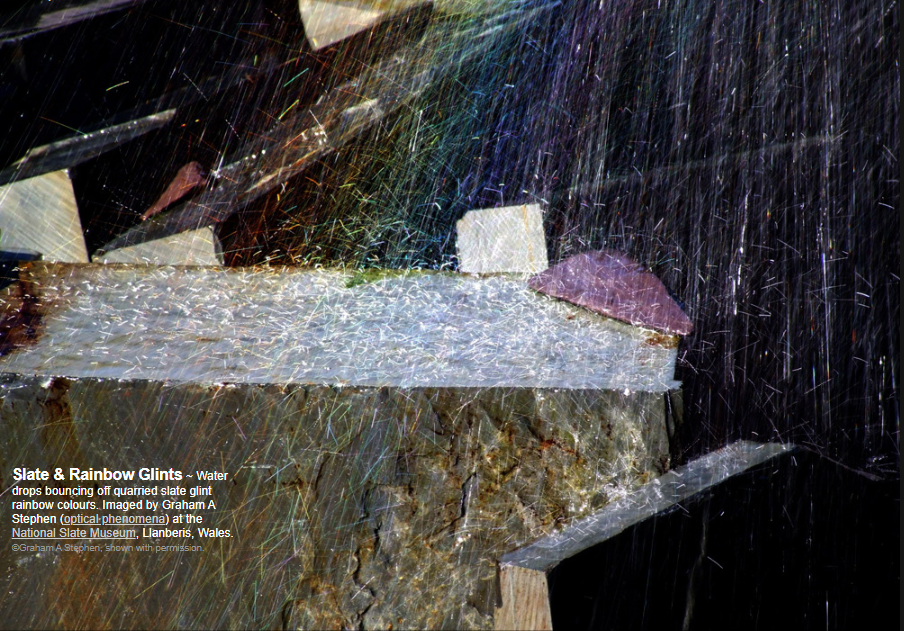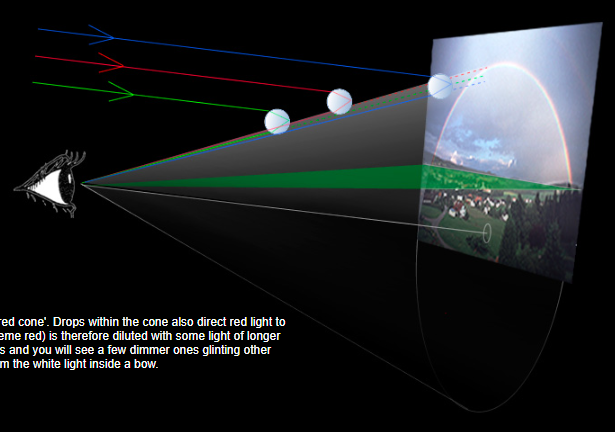Glints & Slate
Glints & Slate: Exploring the Phenomenon of Rainbow Colors on Water Drops
Rainbows have always captivated our imagination with their vibrant colors and ethereal beauty. But have you ever wondered how water droplets bouncing off a surface can create glints of rainbow colors? In this article, we delve into the fascinating world of glints and slate, uncovering the science behind this optical phenomenon.
Understanding the Rainbow Cone
When sunlight interacts with water droplets, it undergoes a series of complex refractions and reflections, ultimately resulting in the formation of a rainbow. However, the colors we see in a rainbow are not evenly distributed. Drops glinting a particular color near the outer rim of the rainbow are situated on or near the surface of a cone known as the "rainbow cone."
- The red cone, being the widest, produces the red outer edge of the primary bow.
- The green and blue cones, on the other hand, are progressively narrower.
Alexander's Dark Band: The Absence of Glints
As we move towards the left side of the rainbow, an intriguing phenomenon known as Alexander's Dark Band comes into play. Here, drops glint no light towards the camera at all. This dark band is a result of drops within the rainbow cone that do not reflect any light directly towards our eyes.
The Role of Droplet Deflection
While the concept of the rainbow cone seems straightforward, droplets actually deflect sunlight through a range of angles. This deflection plays a crucial role in determining the distribution of colors within the rainbow.
- Drops near the surface of the red cone contribute to the red edge of the bow.
- Drops within the cone also direct red light to the eye, diluting other colors of the rainbow (except extreme red) with longer wavelengths.
Unveiling the White Light Inside the Rainbow
If you take a closer look at the individual drops, you might notice a few dimmer ones glinting other colors. These additional colors, when combined, form the white light that brightens the inside of a rainbow. It's the collective effect of these glints that creates the mesmerizing spectacle we all know and love.
The Intricacies of Slate: A Metamorphic Wonder
Now that we understand the science behind glints on water droplets, let's explore the role of slate in this optical phenomenon. Slate is a metamorphic rock formed from shale, which consists of clay minerals heated under pressure to a few hundred degrees. During this process, some clay minerals convert to mica, giving slate its unique properties.
- Cleaved and cut slate, with its distinct cleavage direction, plays a crucial role in producing glints and rainbow colors.
- Skilled hands can quickly split mined slate into thin sheets, making it an ideal material for roofing tiles.
A Glimpse into Slate Mining
Enormous deposits of slate existed in North Wales, leading to the rise of slate mining as a major industry in the 18th century. This labor-intensive process involved hand mining and cutting slate, providing roofs for countless buildings across the United Kingdom.
In conclusion, glints and slate offer us a deeper understanding of the intricate mechanisms behind the formation of rainbows. By unraveling the science behind this optical phenomenon and appreciating the unique properties of slate, we gain a greater appreciation for the beauty and complexity of the natural world around us. So, the next time you catch a glimpse of a rainbow, remember the fascinating interplay between light, water droplets, and the metamorphic wonder that is slate.

Slate & Rainbow Glints ~ Water drops bouncing off quarried slate glint rainbow colours. Imaged by Graham A Stephen (optical phenomena) at the National Slate Museum, Llanberis, Wales. ©Graham A Stephen, shown with permission.
The bow's centre is off the picture to the right. To the left, at the bow�s outer rim, water drops glint red light. Further leftwards they glint no light towards the camera at all � This is Alexander�s Dark Band. Contrast this with the drops to the right. They glint white light and brighten the inside of rainbowS which are disks rather than a rings of light.
Drops glinting a particular colour near the rainbow's rim are on or near the surface of a cone whose apex is at the eye and axis is parallel to the direction of sunlight - a 'rainbow cone'.
The red cone is widest, producing the red outer edge to the primary bow. The green and blue cones are progressively narrower.
It is not altogether that simple. Droplets deflect the sun's rays through a range of angles.
If we think only of red rays, the red edge of the bow is produced by drops near the surface of the 'red cone'. Drops within the cone also direct red light to the eye and any colour of the rainbow (except extreme red) is therefore diluted with some light of longer wavelengths. Look carefully at the individual drops and you will see a few dimmer ones glinting other colours. Together these other colours add up to form the white light inside a bow.


Cleaved and cut slate.
Slate is a metamorphic rock formed when shale consisting of clay minerals is heated under pressure to a few hundred degrees. Some clay minerals convert to mica and the rock develops a particular cleavage direction, not necessarily that of the original clay bedding planes.
In skilled hands, mined slate can be quickly split into thin sheets to form roofing tiles. Enormous deposits of slate existed In North Wales and it was long hand mined and cut. In the 18th Century slate mining became a major industry and literally and laboriously provided a roof for the UK.
Note: this article has been automatically converted from the old site and may not appear as intended. You can find the original article here.
Reference Atmospheric Optics
If you use any of the definitions, information, or data presented on Atmospheric Optics, please copy the link or reference below to properly credit us as the reference source. Thank you!
-
<a href="https://atoptics.co.uk/blog/glints-slate/">Glints & Slate</a>
-
"Glints & Slate". Atmospheric Optics. Accessed on November 26, 2024. https://atoptics.co.uk/blog/glints-slate/.
-
"Glints & Slate". Atmospheric Optics, https://atoptics.co.uk/blog/glints-slate/. Accessed 26 November, 2024
-
Glints & Slate. Atmospheric Optics. Retrieved from https://atoptics.co.uk/blog/glints-slate/.